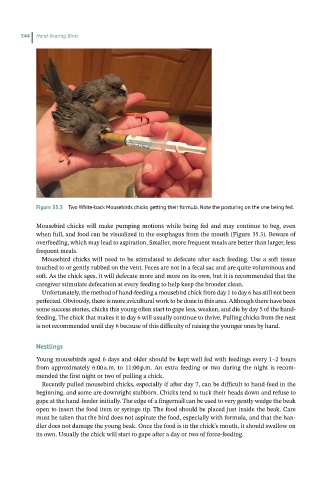Page 545 - Hand rearing birds second
P. 545
544 Hand-Rearing Birds
Figure 35.3 Two White-back Mousebirds chicks getting their formula. Note the posturing on the one being fed.
Mousebird chicks will make pumping motions while being fed and may continue to beg, even
when full, and food can be visualized in the esophagus from the mouth (Figure 35.3). Beware of
overfeeding, which may lead to aspiration. Smaller, more frequent meals are better than larger, less
frequent meals.
Mousebird chicks will need to be stimulated to defecate after each feeding. Use a soft tissue
touched to or gently rubbed on the vent. Feces are not in a fecal sac and are quite voluminous and
soft. As the chick ages, it will defecate more and more on its own, but it is recommended that the
caregiver stimulate defecation at every feeding to help keep the brooder clean.
Unfortunately, the method of hand-feeding a mousebird chick from day 1 to day 6 has still not been
perfected. Obviously, there is more avicultural work to be done in this area. Although there have been
some success stories, chicks this young often start to gape less, weaken, and die by day 5 of the hand-
feeding. The chick that makes it to day 6 will usually continue to thrive. Pulling chicks from the nest
is not recommended until day 6 because of this difficulty of raising the younger ones by hand.
Nestlings
Young mousebirds aged 6 days and older should be kept well fed with feedings every 1–2 hours
from approximately 6:00 a.m. to 11:00 p.m. An extra feeding or two during the night is recom-
mended the first night or two of pulling a chick.
Recently pulled mousebird chicks, especially if after day 7, can be difficult to hand-feed in the
beginning, and some are downright stubborn. Chicks tend to tuck their heads down and refuse to
gape at the hand-feeder initially. The edge of a fingernail can be used to very gently wedge the beak
open to insert the food item or syringe tip. The food should be placed just inside the beak. Care
must be taken that the bird does not aspirate the food, especially with formula, and that the han-
dler does not damage the young beak. Once the food is in the chick’s mouth, it should swallow on
its own. Usually the chick will start to gape after a day or two of force-feeding.

